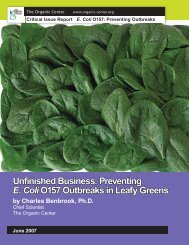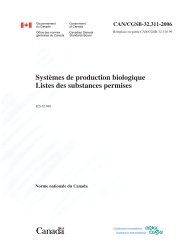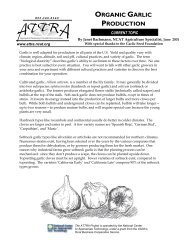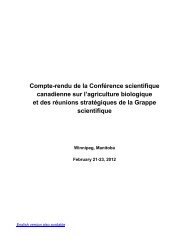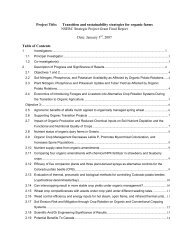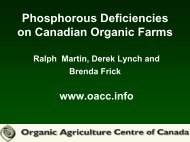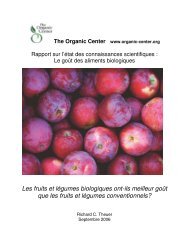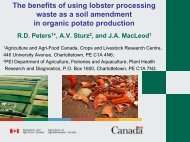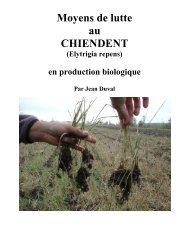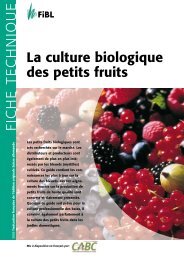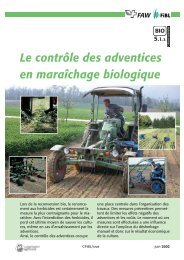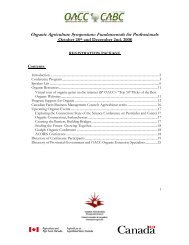Managing wild radish in feed grains
Managing wild radish in feed grains
Managing wild radish in feed grains
You also want an ePaper? Increase the reach of your titles
YUMPU automatically turns print PDFs into web optimized ePapers that Google loves.
MANAGING WILD RADISH IN FEED GRAINS<br />
F<strong>in</strong>al Research Report E2006-01<br />
INTRODUCTION<br />
Weed control problems are one of the ma<strong>in</strong><br />
reasons many farmers don’t switch to organic<br />
production. Farmers <strong>in</strong>dicate that ‘<strong>wild</strong> mustard’<br />
(Synapis arvensis) is one of the most problematic<br />
weeds <strong>in</strong> the Maritimes. Although <strong>wild</strong> mustard<br />
has been seen <strong>in</strong> the Maritimes, <strong>wild</strong> <strong>radish</strong><br />
(Raphanus raphanistrum) is much more common<br />
and is often is misidentified as <strong>wild</strong> mustard (see<br />
adjacent text box). Wild <strong>radish</strong> is highly visible<br />
dur<strong>in</strong>g their flower<strong>in</strong>g period mak<strong>in</strong>g farmers are<br />
concerned about both the appearance of poor<br />
weed management and the actual yield losses<br />
caused by the weed.<br />
Wild <strong>radish</strong> can reduce yield and seed quality of<br />
the harvested crop 1 . Researchers have found that<br />
7 <strong>wild</strong> <strong>radish</strong> plants m -2 reduced wheat yield by<br />
10%, and at a density of 200 plants m -2 , yield<br />
was reduced by half 2 . Wild <strong>radish</strong> is not a seed<br />
limited weed. It produces many seeds per plant<br />
that may survive <strong>in</strong> the soil for decades. It is<br />
better to not allow a field to get weedy; as seed<br />
production is hard to control. To control <strong>wild</strong><br />
<strong>radish</strong>, it is recommended that organic farmers<br />
use a systems approach that comb<strong>in</strong>es strategies<br />
such as crop rotations, cultivation, prevention<br />
systems, and plant<strong>in</strong>g methods 3 (see Table 1).<br />
Farmers <strong>in</strong> PEI requested an on-farm research<br />
and demonstration trials designed to identify<br />
successful weed control practices for <strong>wild</strong> <strong>radish</strong><br />
<strong>in</strong> organic <strong>feed</strong> gra<strong>in</strong>s. For this study, we studied<br />
the literature and developed what we identified to<br />
be the theoretically ideal management system.<br />
We referred to this system as the Best Organic<br />
Management Practice, or “BOMP”.<br />
The objectives of this research were to:<br />
• Conduct on-farm research to test the<br />
effectiveness of (BOMPs) for controll<strong>in</strong>g<br />
<strong>wild</strong> <strong>radish</strong>; and<br />
• Estimate the yield loss caused by <strong>wild</strong><br />
<strong>radish</strong>.<br />
Wild Radish or Mustard?<br />
Both <strong>wild</strong> <strong>radish</strong> and <strong>wild</strong> mustard are highly visible<br />
when flower<strong>in</strong>g. They can be taller than the crop,<br />
with bright yellow flowers and many branches. In<br />
PEI, <strong>wild</strong> <strong>radish</strong> is more prevalent than <strong>wild</strong><br />
mustard. If <strong>in</strong> doubt, the follow<strong>in</strong>g clues can be<br />
used to identify your weed.<br />
Wild <strong>radish</strong> has:<br />
- deeply divided lower leaves covered <strong>in</strong> stiff<br />
hairs 4<br />
- yellow or white flower petals with eyecatch<strong>in</strong>g<br />
dark ve<strong>in</strong>s 4<br />
- pods that hold a few large seeds<br />
- pods constrict around and break between<br />
the seeds 4 (i.e. the pods do not open,<br />
mak<strong>in</strong>g <strong>wild</strong> <strong>radish</strong> difficult to clean out of<br />
cereal seed because of their similar size and<br />
shape)<br />
- a root with a spicy, peppery taste<br />
Wild mustard has:<br />
- less hairy leaves<br />
- leaves are not deeply lobed<br />
- stems are bristly 4<br />
- stems are purplish where they branch 4<br />
- seed pods that conta<strong>in</strong> many small seeds<br />
and split open lengthwise 1<br />
Flower<strong>in</strong>g <strong>wild</strong> <strong>radish</strong> <strong>in</strong> a barley crop (K. Punnett)<br />
1
WHAT WAS DONE?<br />
The BOMP trial was conducted on two PEI farms.<br />
Both farms were <strong>in</strong>terested <strong>in</strong> test<strong>in</strong>g new weed<br />
management practices, and were <strong>in</strong> the early<br />
stages of adopt<strong>in</strong>g organic management. Early <strong>in</strong><br />
the year, <strong>wild</strong> <strong>radish</strong> (not <strong>wild</strong> mustard) was<br />
identified as the problem weed <strong>in</strong> these fields.<br />
The BOMP plots were managed with practices<br />
designed to control <strong>wild</strong> <strong>radish</strong>. Table 1 lists<br />
examples of BOMPs that may be useful for <strong>wild</strong><br />
<strong>radish</strong> control, as determ<strong>in</strong>ed through a literature<br />
review. For this project, the BOMPs chosen<br />
comb<strong>in</strong>e several techniques <strong>in</strong>clud<strong>in</strong>g false seed<br />
bed technique, roll<strong>in</strong>g after tillage, <strong>in</strong>creas<strong>in</strong>g<br />
seed<strong>in</strong>g rate, and f<strong>in</strong>gerweed<strong>in</strong>g (Table 2).<br />
The NORM plots were managed with the farmers’<br />
normal practices.<br />
The false seed bed technique is used early <strong>in</strong> the<br />
grow<strong>in</strong>g season to stimulate weed germ<strong>in</strong>ation.<br />
The field is cultivated twice. The first cultivation<br />
encourages weed germ<strong>in</strong>ation, and the second<br />
(7-10 days later) kills off any weeds that emerge.<br />
The crop is planted soon after <strong>in</strong>to this “stale”<br />
seedbed. This operation is best done <strong>in</strong> the<br />
morn<strong>in</strong>g on a sunny day so uprooted weeds will<br />
dry out and not re-establish. Higher seed<strong>in</strong>g<br />
rates will make the crop more competitive, and<br />
compensate for crop losses due to post-emergent<br />
f<strong>in</strong>gerweed<strong>in</strong>g.<br />
Table 1. Best Management Practices for Wild Radish Control 2,3<br />
Prevention<br />
• Use clean seed<br />
• Scout your field and rogue at flower<strong>in</strong>g <strong>in</strong> the first year weeds are spotted (Don’t wait until next year!)<br />
• Use a modified swather to reduce seed production by cutt<strong>in</strong>g the tops of weeds above the gra<strong>in</strong> <strong>in</strong> July<br />
Diversify Crop Rotations<br />
• Longer term crops (pasture, forage)<br />
• Crops that develop rapidly with full canopies<br />
• Sturdy crops that allow aggressive mechanical weed<strong>in</strong>g (potatoes and turnips)<br />
• No-till seed<strong>in</strong>g of fall seeded crops (w<strong>in</strong>ter rye, hairy vetch) to m<strong>in</strong>imize seedbank disturbance<br />
• Modify accord<strong>in</strong>g to field history and future needs<br />
Primary Cultivation<br />
• In a clean field: M<strong>in</strong>imize <strong>in</strong>version/vertical mix<strong>in</strong>g<br />
• In a weedy field:<br />
- Maximize shallow tillage before or at the first true leaf stage (<strong>in</strong> top 5 cm)<br />
- Mow green manures to form a mulch, then till <strong>in</strong>to soil before sow<strong>in</strong>g (use oats, barley, legumes, rye, hairy<br />
vetch, red clover)<br />
- Use smother crops (oats, barley, rye, vetch)<br />
- Include a period of fallow<br />
Secondary Cultivation<br />
• Tillage should be shallow, above 5 cm<br />
• Promote germ<strong>in</strong>ation of weed seeds by:<br />
- Pack or roll after tillage to ensure good contact between the weed seed and soil<br />
- Use shallow cultivation to alternate light/dark, which can trigger germ<strong>in</strong>ation<br />
• Create false seed bed then follow with a stale seed bed (repeated pack<strong>in</strong>g and shallow tillage):<br />
- Create <strong>in</strong>itial seedbed with 1 cm tillage<br />
- Promote weed germ<strong>in</strong>ation<br />
- Cultivate/harrow to kill weeds 2–3 times<br />
- Drill crop 4-7 days after first tillage (perhaps longer for fast germ<strong>in</strong>at<strong>in</strong>g crop seeds)<br />
• Bl<strong>in</strong>d harrow<strong>in</strong>g at the pre-emergent or post-emergent (3-5 leaf) stage for cereals that are deeply drilled and robust<br />
• After drill<strong>in</strong>g the crop, control weeds with thermal/flame weed<strong>in</strong>g, cha<strong>in</strong> harrow<br />
• Frequent mow<strong>in</strong>g can prevent weed seed set<br />
Sow<strong>in</strong>g Crop<br />
• Increase seed<strong>in</strong>g rates by 10-20% and cross seed with 2 passes to <strong>in</strong>crease crop competitiveness and compensate<br />
for mechanical weed<strong>in</strong>g losses<br />
• Accuracy with drill<strong>in</strong>g is important to ensure no gaps occur between the runs<br />
• If possible, use wide rows with twice the normal seed<strong>in</strong>g rate <strong>in</strong> each row to allow aggressive <strong>in</strong>terrow cultivation<br />
Harvest<strong>in</strong>g<br />
• Capture weed seeds with a chaff collector on comb<strong>in</strong>e<br />
Elim<strong>in</strong>at<strong>in</strong>g Autumn Flushes<br />
• Seed<strong>in</strong>g a w<strong>in</strong>ter cereal or a cover crop us<strong>in</strong>g cultivation practices described above where possible<br />
• Underseed<strong>in</strong>g a forage crop with the spr<strong>in</strong>g crop will elim<strong>in</strong>ate tillage and will compete with weeds <strong>in</strong> the fall<br />
2
Table 2.Treatment details of BOMP and<br />
NORM operations at two organic farms<br />
<strong>in</strong> PEI, 2005<br />
Farm #1 (Oat- Barley)<br />
Both NORM Disc and S-t<strong>in</strong>e<br />
and BOMP F<strong>in</strong>gerweed<strong>in</strong>g before seed<strong>in</strong>g<br />
Post-emergent f<strong>in</strong>gerweed<strong>in</strong>g<br />
BOMP Roll after first cultivation<br />
Increased seed<strong>in</strong>g rate<br />
Pre-emergent f<strong>in</strong>gerweed<strong>in</strong>g<br />
Farm #2 (Barley)<br />
Both NORM Chisel plow and cultivate<br />
and BOMP Roll after seed<strong>in</strong>g<br />
High and low seed<strong>in</strong>g rate<br />
Post-emergent f<strong>in</strong>gerweed<strong>in</strong>g<br />
Underseed<strong>in</strong>g<br />
BOMP Use of false seedbed<br />
Increased seed<strong>in</strong>g rate<br />
Pre-emergent f<strong>in</strong>gerweed<strong>in</strong>g<br />
Roll<strong>in</strong>g after tillage to pack the seed bed<br />
encourages weed seed germ<strong>in</strong>ation.<br />
F<strong>in</strong>gerweed<strong>in</strong>g cultivates the soil very shallowly,<br />
so can be used for pre-emergent and postemergent<br />
operations without significant crop<br />
damage. F<strong>in</strong>gerweed<strong>in</strong>g is most effective <strong>in</strong> kill<strong>in</strong>g<br />
small weed seedl<strong>in</strong>gs. Although there is some risk<br />
to the crop, a post-emergent f<strong>in</strong>gerweed<strong>in</strong>g can<br />
be done at the crop’s 3-5 leaf stage to reduce<br />
competition from late-emerg<strong>in</strong>g weeds.<br />
To compare the treatments, we measured crop<br />
establishment, <strong>wild</strong> <strong>radish</strong> and total weed density<br />
and biomass (fresh weight), and crop yield.<br />
WHAT HAPPENED?<br />
At Farm #1, an oat-barley (3:1) mixed crop was<br />
grown at a field scale with several strips each of<br />
the BOMP and NORM treatments (Table 2). The<br />
<strong>in</strong>crease <strong>in</strong> seed<strong>in</strong>g rate applied to the BOMP<br />
plots did not have a large effect on crop density,<br />
with an average of around 155 plants m -2 across<br />
all treatments.<br />
The BOMP treatment reduced the biomass and<br />
density of <strong>wild</strong> <strong>radish</strong> compared with the NORM.<br />
This was most likely as a result of pre-emergent<br />
f<strong>in</strong>gerweed<strong>in</strong>g. August <strong>wild</strong> <strong>radish</strong> densities were<br />
reduced on average from 3.44 plants m -2 <strong>in</strong> the<br />
NORM to 0.48 plants m -2 <strong>in</strong> the BOMP. Wild<br />
<strong>radish</strong> fresh weight was 2.5% of the total weed<br />
weight <strong>in</strong> the BOMP, and 17% of the total weight<br />
<strong>in</strong> the NORM. Although <strong>wild</strong> <strong>radish</strong> was reduced,<br />
there was not a higher yield <strong>in</strong> the BOMP<br />
treatments. Other weeds were more problematic<br />
than <strong>wild</strong> <strong>radish</strong>, especially couchgrass (also<br />
known as quackgrass). Yield was reduced<br />
substantially by the couchgrass; the BOMP<br />
treatments did not help to control this weed.<br />
Although <strong>wild</strong> <strong>radish</strong> is a highly visible weed <strong>in</strong><br />
the field, other weeds may be an even bigger<br />
problem. It is important to consider all of the<br />
weeds together when develop<strong>in</strong>g a management<br />
plan. A guide for couchgrass (quackgrass) control<br />
written by Jean Duval <strong>in</strong> Québec can be accessed<br />
on the OACC website 5 .<br />
At Farm #2, barley was seeded at two rates<br />
(130 and 160 lbs ac -1 ) across both the BOMP and<br />
NORM treatments. Barley density was low overall<br />
at 60-75 plants m -2 , possibly due to losses from<br />
post-emergent f<strong>in</strong>gerweed<strong>in</strong>g. We didn’t measure<br />
a big difference <strong>in</strong> the number of plants result<strong>in</strong>g<br />
from the different seed<strong>in</strong>g rates. At harvest,<br />
there were slightly more heads m -2 (ma<strong>in</strong>stems<br />
plus tillers) <strong>in</strong> the BOMP treatments, and at high<br />
seed<strong>in</strong>g rates, but the difference wasn’t large<br />
enough to be statistically significant.<br />
Wild <strong>radish</strong> density ranged from 0-44 plants m -2 ,<br />
averag<strong>in</strong>g 3.3 plants m -2 . The BOMP treatments<br />
did reduce the density of <strong>radish</strong> plants <strong>in</strong> the<br />
crop; however, it did not reduce the biomass.<br />
Weed biomass (g m -2 )<br />
360<br />
320<br />
280<br />
240<br />
200<br />
160<br />
120<br />
80<br />
40<br />
0<br />
BOMP NORM BOMP NORM<br />
Low seed<strong>in</strong>g rate<br />
High seed<strong>in</strong>g rate<br />
Other Weeds<br />
Wild Radish<br />
Figure 1. Total weed and <strong>wild</strong> <strong>radish</strong> biomass: Farm #2<br />
3
The tillage operations appeared to reduce the<br />
<strong>wild</strong> <strong>radish</strong> population, but the smaller number of<br />
weeds compensated by <strong>in</strong>creas<strong>in</strong>g <strong>in</strong> size.<br />
Despite a relatively small difference <strong>in</strong> the crop<br />
density between seed<strong>in</strong>g rates, <strong>in</strong>creas<strong>in</strong>g<br />
seed<strong>in</strong>g rate reduced the biomass of <strong>wild</strong> <strong>radish</strong>,<br />
<strong>in</strong> both the BOMP and NORM treatments (Figure<br />
1). The higher seed<strong>in</strong>g rate also made the crop<br />
more competitive with other weeds. Biomass of<br />
weeds other than <strong>wild</strong> <strong>radish</strong> was highest <strong>in</strong> the<br />
low seed<strong>in</strong>g rate of the BOMP treatment.<br />
SUMMARY<br />
Overall, a comb<strong>in</strong>ation of BOMP treatments and a<br />
high seed<strong>in</strong>g rate proved to be the best way to<br />
reduce both density and biomass of <strong>wild</strong> <strong>radish</strong>.<br />
Although we did observe changes <strong>in</strong> weed<br />
competition, neither the <strong>in</strong>creased seed<strong>in</strong>g rates<br />
nor the BOMP practices <strong>in</strong>creased crop yield.<br />
However, effective management of <strong>wild</strong> <strong>radish</strong><br />
will reduce the number of seeds produced and<br />
lessen potential problems <strong>in</strong> future years. Our<br />
BOMP practices were not effective on all other<br />
weeds. Couchgrass is a very different weed from<br />
<strong>wild</strong> <strong>radish</strong> so this is not surpris<strong>in</strong>g. The<br />
effectiveness of the BOMP practices identified <strong>in</strong><br />
this research for controll<strong>in</strong>g other weeds needs to<br />
be studied further.<br />
THE BOTTOM LINE…<br />
A systems approach to <strong>wild</strong> <strong>radish</strong> control<br />
can reduce weed competition <strong>in</strong> organic<br />
<strong>feed</strong> gra<strong>in</strong>s.<br />
Us<strong>in</strong>g a comb<strong>in</strong>ation of stale seed bed<br />
techniques, <strong>in</strong>creased seed<strong>in</strong>g rate, and<br />
pre-emergent and post-emergent<br />
f<strong>in</strong>gerweed<strong>in</strong>g provides the most effective<br />
<strong>wild</strong> <strong>radish</strong> control.<br />
REFERENCES<br />
1<br />
Cheam, A. H. and Code, G. R. 1995. The biology of<br />
Australian weeds. 24. Raphanus raphanistrum L. Plant Prot.<br />
Quart. 10:1-13.<br />
2<br />
Effects of Weeds on Wheat. 21 June 2001. Agriculture, Food<br />
and Rural Development.<br />
(http://www1.agric.gov.ab.ca/$department/deptdocs.nsf/all/c<br />
rop1280?opendocument)<br />
3<br />
Bond, W. and Turner, R.J. 2004. The biology and nonchemical<br />
control of Wild Radish. HDRA: The Organic<br />
Association. (http://www.organicweeds.org.uk)<br />
4 Royer, F. and Dick<strong>in</strong>son R. 1999. Weeds of Canada and the<br />
Northern United States. Lone P<strong>in</strong>e Publish<strong>in</strong>g.<br />
5<br />
Duval, Jean. Quackgrass (Elytrigia repens) control methods<br />
<strong>in</strong> organic agriculture.<br />
(http://oacc.<strong>in</strong>fo/Docs/Quackgrass_f<strong>in</strong>al_rev_JD.pdf)<br />
ACKNOWLEDGEMENTS<br />
The participation and support of Carey Gillis<br />
(Belle River, PEI), Laura and Robert Rob<strong>in</strong>son<br />
(Pisquid, PEI), Susan McK<strong>in</strong>non (PEI Department<br />
of Agriculture, Fisheries and Aquaculture), and<br />
OACC technicians is greatly appreciated.<br />
FUNDING<br />
Pr<strong>in</strong>ce Edward Island Department of Agriculture,<br />
Fisheries and Aquaculture<br />
Post-emergent f<strong>in</strong>gerweed<strong>in</strong>g for weed control (K.<br />
Punnett)<br />
CREDITS<br />
Andy Hammermeister, Kate Punnett and Roxanne<br />
Beavers (ed.)<br />
For more <strong>in</strong>formation:<br />
Visit oacc.<strong>in</strong>fo or contact us at<br />
P.O. Box 550 Truro, NS B2N 5E3<br />
Tel: (902) 893-7256<br />
Fax: (902) 896-7095<br />
Email: oacc@nsac.ca<br />
4



